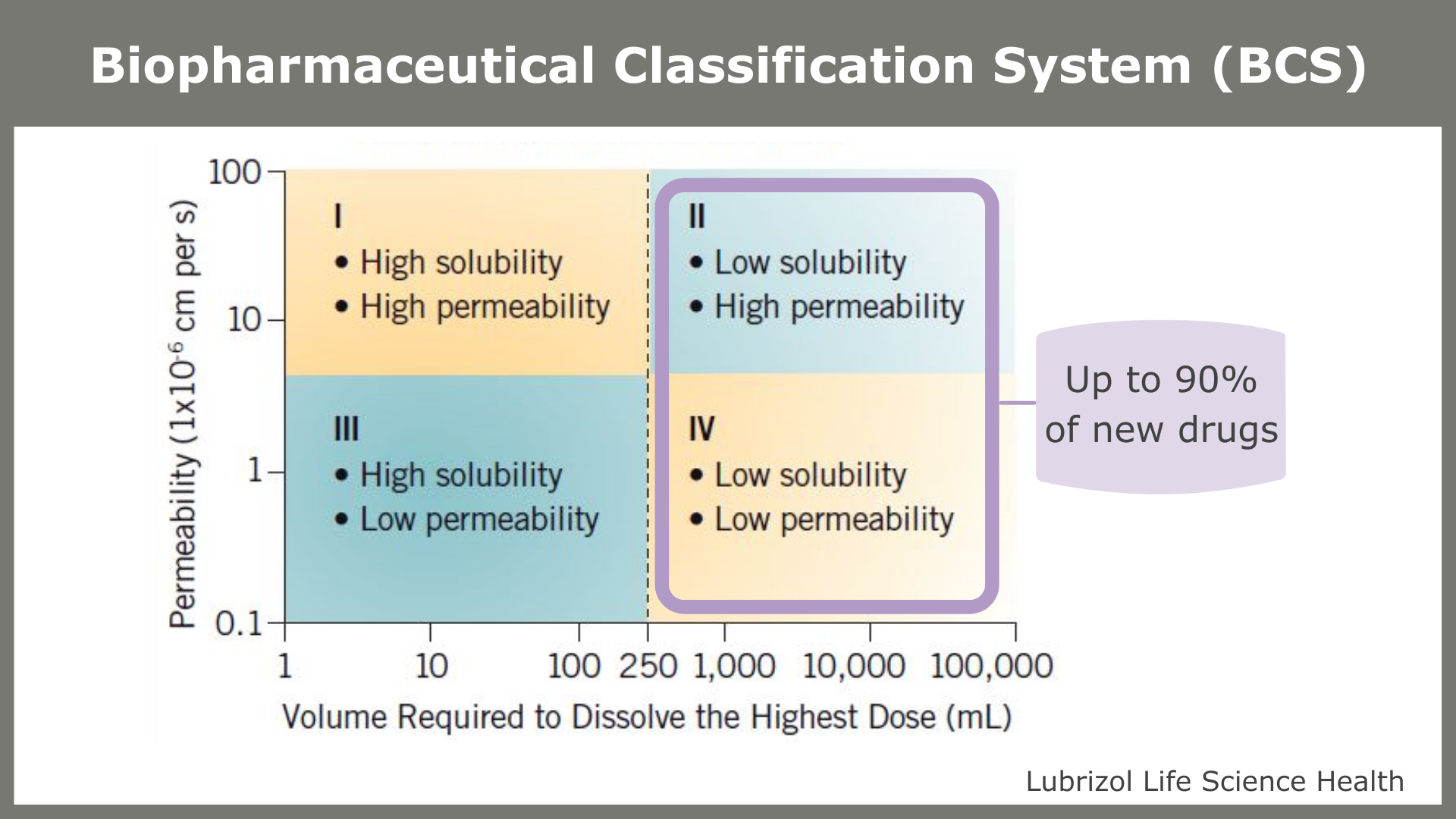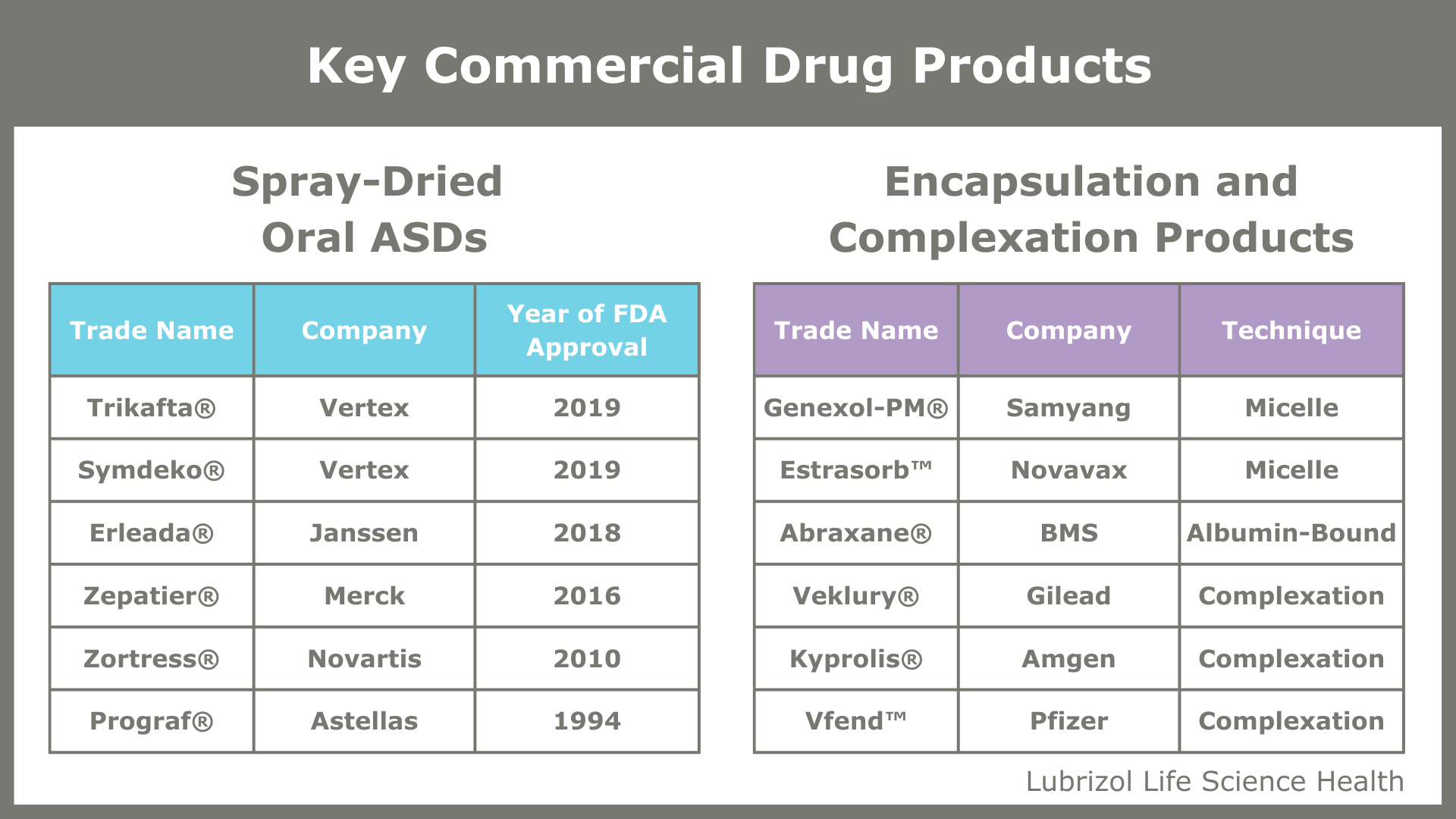Lubrizol Life Science Health is committed to providing best-in-class excipients and services that address solubility and bioavailability challenges. In this blog post, we discuss formulation tactics for BCS Class II and IV APIs and introduce Lubrizol’s novel solubility-enhancing excipients, oral-grade Apinovex™ polymer and injectable-grade Apisolex™ polymer.
Poor solubility is a common and growing challenge in drug product development, affecting between 40 and 70% of marketed drugs, and up to 90% of new chemical entities (NCEs). In previous blog posts, we’ve explored the impact of solubility and bioavailability challenges on pharmaceutical innovation and described approaches to solve this problem, such as:
- API chemical modification
- Encapsulation
- Inclusion complexes
- API physical modification and dispersion
While there are several tactics for addressing poor solubility, these techniques often require specialized knowledge or involve complex manufacturing processes that are difficult to optimize. To ensure the continued development of novel and effective pharmaceuticals, it is important to find efficient, scalable methods for formulating BCS Class II and IV drugs (Figure 1).

Excipient-enabled approaches to solubility enhancement are an appealing option because they often leverage established formulation techniques. Below, we will focus on the use of amorphous solid dispersions and micelles for solubility enhancement.
Excipients for Oral and Injectable Solubility Enhancement
For decades, amorphous solid dispersions (ASDs) and encapsulation/complexation techniques have been utilized to enhance pharmaceutical solubility and bioavailability (see Table 1). These techniques enhance the solubility of hydrophobic APIs by maintaining drug particles in an amorphous state or solubilizing the API in a polymeric structure, respectively.

With the growth of poorly water-soluble APIs in the development pipeline and rising interest in 505(b)(2) filings, excipient-led approaches to formulating BCS Class II and IV compounds are becoming increasingly important.
Approach #1: Amorphous Solid Dispersions
Preparation methods to form amorphous solid dispersions include hot-melt extrusion and solvent evaporation processes, such as spray-drying. These techniques are often used to produce oral solid dosage forms.
Pharmaceutical spray drying is a continuous process wherein a liquid feed of API, polymer, and solvent is atomized, dried, and collected as solid particles. Spray drying applies to a broad range of APIs and excipients—provided they are soluble in volatile organic solvents.
When selecting excipient(s) for spray drying, there are several factors to consider, including solubility in common pharmaceutical solvents, the viscosity of the polymer in solution, and the ability to stabilize a high amount of drug in an amorphous form.
Apinovex™ Polymers: Enabling Highly Efficient Amorphous Solid Dispersions
Lubrizol’s Apinovex™ polymers are high molecular weight polyacrylic acid excipients designed to provide both processing and formulation benefits for spray-dried amorphous solid dispersions. Apinovex polymers enable formulators to enhance the solubility of BCS Class II and IV APIs and develop more efficient oral dosage forms.
Formulation Benefits of Apinovex Polymers:
- High drug loading (up to 80%) via spray drying
- Significantly improved dissolution compared to crystalline API
- Stable amorphous solid dispersions even after 6 months at accelerated conditions
- Enables IP protection and lifecycle management/505(b)(2) formulations
- High glass transition temperature ensures stability of the ASD
Processing Benefits of Apinovex Polymers:
- Designed for standard spray drying and solvent-based processing techniques
- Soluble in water and common pharmaceutical solvents
- Produces low viscosity solutions for ease of processing
Apinovex polymers are safe and compatible with a wide range of APIs. The polymer has been commercially manufactured according to IPEC-GMP guidelines and samples are available now to evaluate in your next project.
Approach #2: Polymeric Micelle-Based Injectable Formulations
Poor solubility is also a major barrier for injectable formulations. Micelles have been used in multiple commercial drug products to encapsulate and solubilize APIs for injection.
Amphiphilic compounds are molecules with a hydrophilic head and a hydrophobic tail. When these compounds aggregate, they form micelles, which are typically spherical structures (although other conformations are possible). The outer surface of the micelle consists of hydrophilic heads that face the surrounding aqueous environment, whereas the hydrophobic tails face inwards, forming a space where hydrophobic APIs are soluble.
Amphiphilic block copolymers have the ability to self-assemble and generate micellar structures offering solubilization properties, while having better safety profile compared with small molecule surfactants.
Apisolex™ Polymers: Increase Solubility up to 50,000x Where Others Fail
The Apisolex polymer is a versatile, efficient, and safe excipient technology employing a poly(amino acid) architecture to overcome the pitfalls of existing technologies. Apisolex technology enjoys robust patent protection, both in the US and internationally, which allows for applications with new chemical entities and drug products entering the market via the FDA’s 505(b)(2) regulatory pathway.
Both amorphous and highly crystalline hydrophobic APIs can be formulated using Apisolex technology. It decreases the amount of excipient required to solubilize a hydrophobic API compared to alternative excipients on the market, including Captisol® and other cyclodextrins. As such, Apisolex excipients enable the efficient development of next-generation parenteral products.
The Apisolex excipient’s poly (amino acid) amphiphilic architecture is constructed of building blocks, which naturally occur in the body. This ensures a non-toxic, non-immunogenic, biocompatible, and biodegradable alternative to PEG and other common solubility enhancers. The excipient is made according to Good Manufacturing Practices (GMPs) and is ready for use in clinical and commercial drug product manufacturing.
Apisolex technology is an integral solution for parenteral drug development projects where traditional excipients or other formulation techniques have failed or where a patent-protected technology is desired.
Learn More or Request a Sample Today
LLS Health is dedicated to ensuring there are effective and reliable excipients available to address solubility issues in oral and injectable formulations. To learn more or request samples of our solubility-enhancing polymers, visit the links below:





